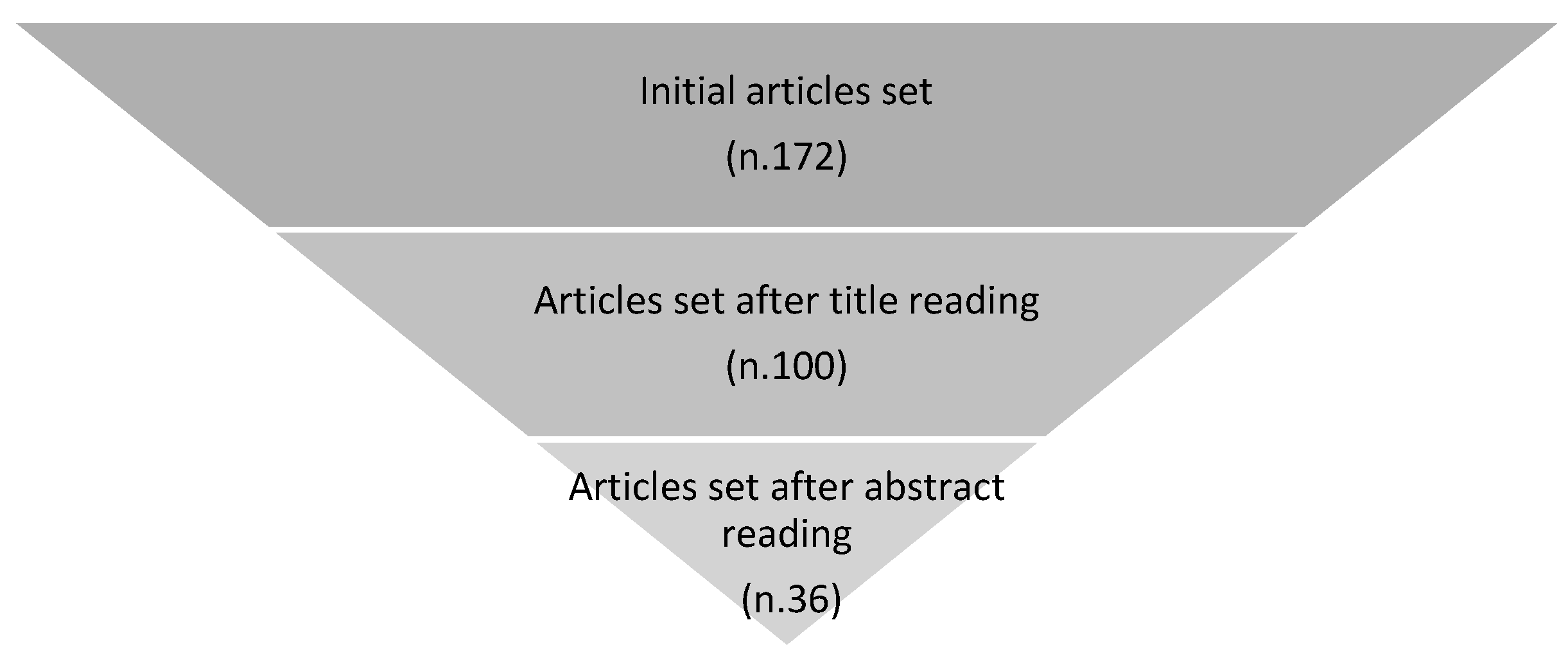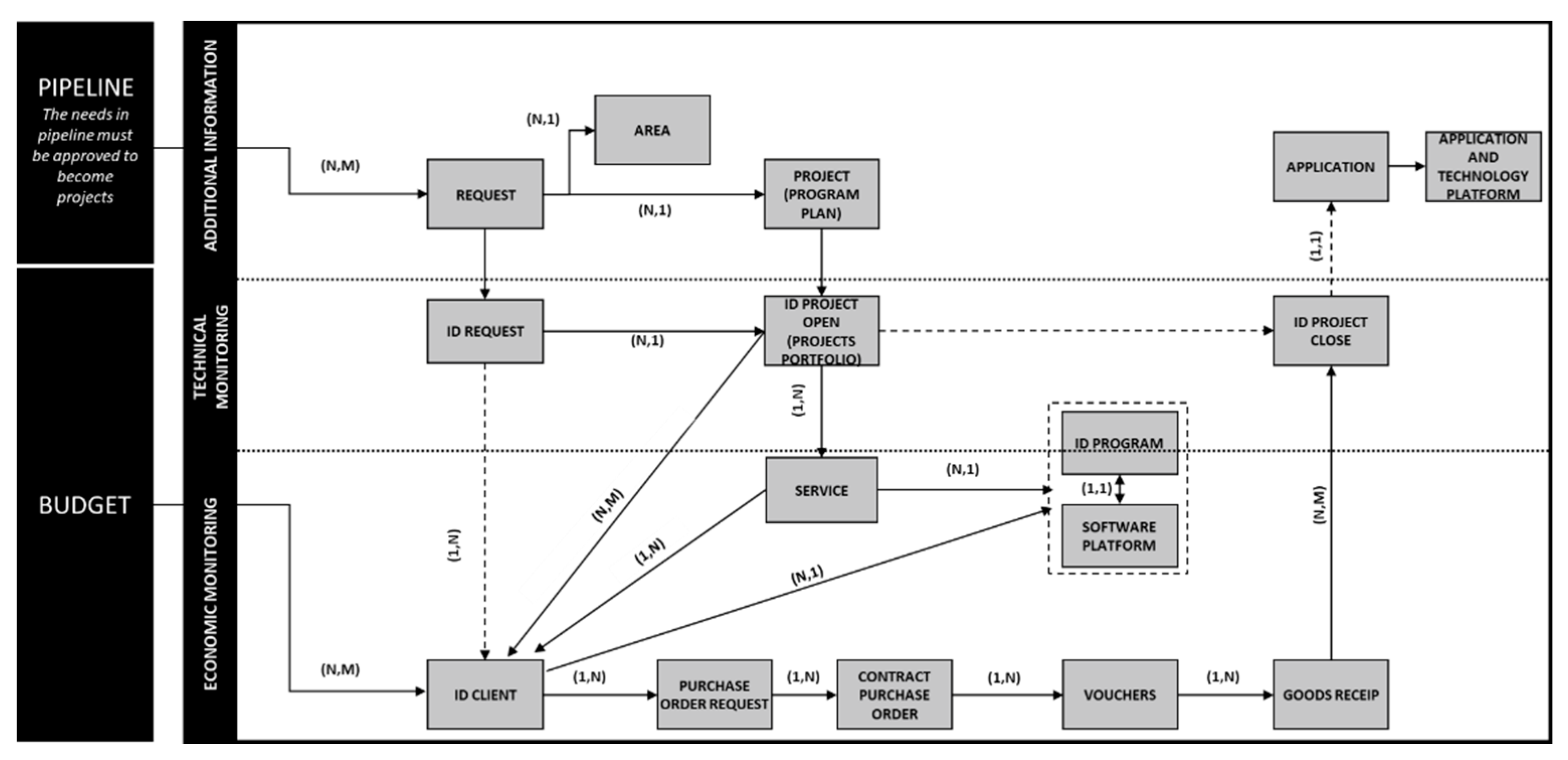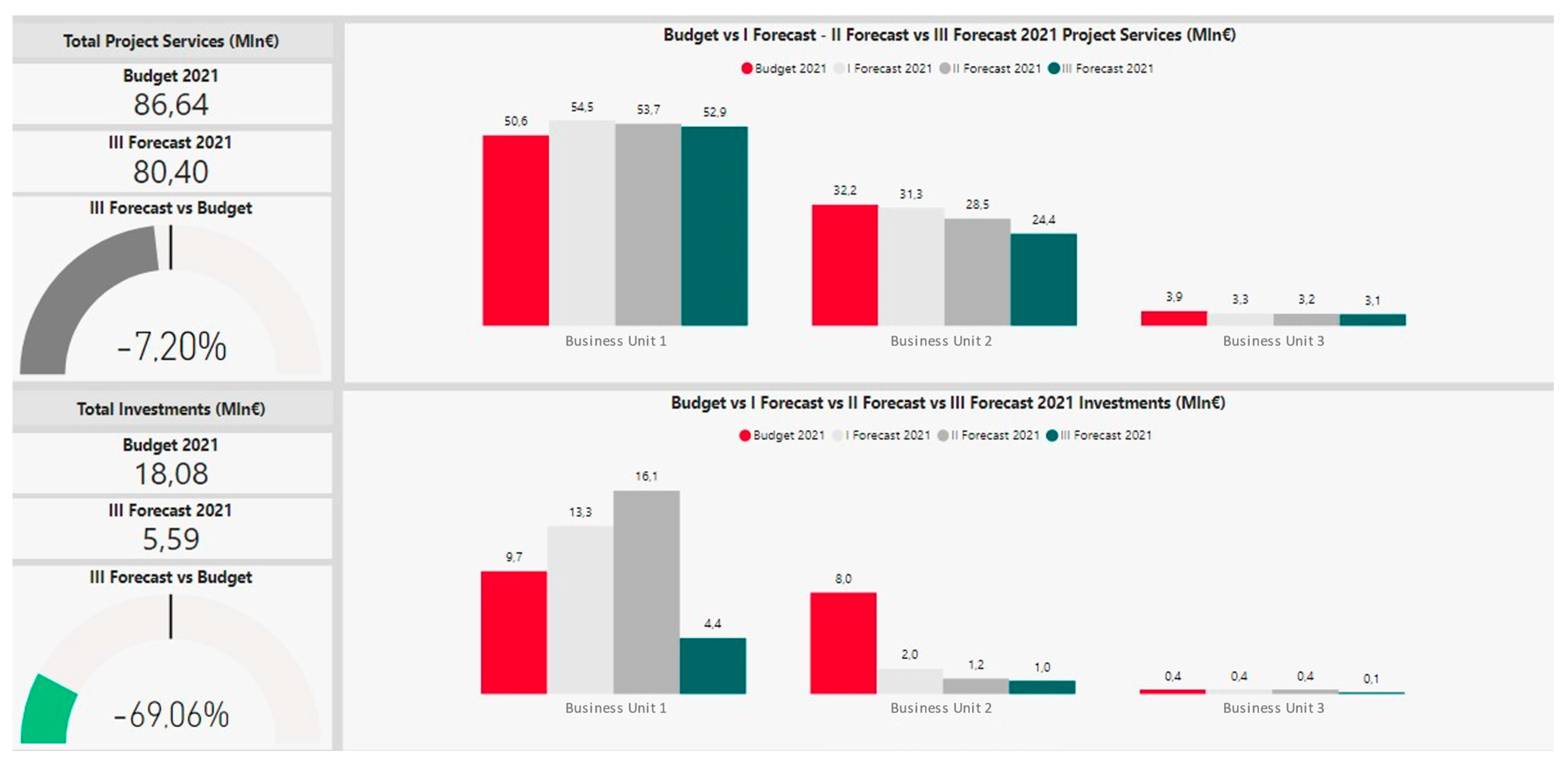Business Intelligence for IT Governance of a Technology Company
Abstract
1. Introduction
2. Theoretical Background
2.1. Performance Management
2.2. Business Analytics
2.3. Business Analytics Background
3. Results
3.1. Data Model
- Completeness: The ability to measure the overall created value;
- Relevance: The system is strictly related to the decision-making phase of the company so that it can cover the critical area for the management at any moment;
- Selectivity: A balanced quantity of information delivered, without information overloading;
- Flexibility: The system must follow the rapid change of the strategic area (e.g., in the current environment, the strategic factor or the critical area for a company changes rapidly);
- Understandability: Information can rapidly spread through the organization so that the company staff can understand actual performance, critical variables, achieved results, and processes implementation status;
- Timing: The capability to produce and transmit information at the right time and with the right frequency customized to support company decision-making.
3.2. Data Classification and Collection
- Descriptive analytics: To support the answer to questions about past events and historical data, by summarizing large sets of data to highlight the outcomes;
- Diagnostic analytics: To examine closely the descriptive analytics results to find the cause;
- Predictive Analytics: To enable the prediction of certain phenomena based on historical data;
- Prescriptive Analytics: To help to answer questions about how to solve a certain problem and allow the business to make a fact-based decision;
- Cognitive Analytics: To attempt to drew inferences (i.e., an unstructured hypothesis based on queries from different sources) and use different data and patterns for self-learning, to thus learn what might change if a certain circumstance changes.
3.3. KPI Mapping
3.4. Business Intelligence
4. Discussion
5. Conclusions
Author Contributions
Funding
Institutional Review Board Statement
Informed Consent Statement
Data Availability Statement
Conflicts of Interest
| 1 | is the budget year, is the project referred to the business unit, and the programme, where is the business unit index, and is the program index, r. |
| 2 | is the budget year, is the project referred to the business unit, and the client, where is the business unit index, and is the client index. |
References
- Rajeshkumar, V.; Anandaraj, S.; Kavinkumar, V.; Elango, K.S. Analysis of factors influencing formwork material selection in construction buildings. Mater. Today Proc. 2020. [Google Scholar] [CrossRef]
- Pajić, A.; Pantelić, O.; Stanojević, B.; Pajić, A.; Pantelić, O.; Stanojević, B. Representing IT Performance Management as Metamodel. Int. J. Comput. Commun. Control ISSN 2014, 9, 758–767. [Google Scholar] [CrossRef][Green Version]
- Sirisomboonsuk, P.; Gu, V.C.; Cao, R.Q.; Burns, J.R. Relationships between project governance and information technology governance and their impact on project performance. Int. J. Proj. Manag. 2018, 36, 287–300. [Google Scholar] [CrossRef]
- Erasmus, W.; Marnewick, C. An IT governance framework for IS portfolio management. Int. J. Manag. Proj. Bus. 2020, 14, 721–742. [Google Scholar] [CrossRef]
- Yigitbasioglu, O.M. Drivers of management accounting adaptability: The agility lens. J. Account. Organ. Chang. 2017, 13, 262–281. [Google Scholar] [CrossRef]
- Otley, D. Management control and performance management: Whence and whither? Br. Account. Rev. 2003, 35, 309–326. [Google Scholar] [CrossRef]
- Hope, J.; Fraser, R. New Ways of Setting Rewards: The beyond Bugeting Model; California Management Review: Berkeley, CA, USA, 2003. [Google Scholar]
- Nardo, M.; Saisana, M.; Saltelli, A.; Tarantola, S. Tools for Composite Indicators Building; European Commission: Ispra, Italy, 2005. [Google Scholar]
- Alaeddini, M.; Hashemi, S.A. Evaluating the Performance of IT Governance in Service-Oriented Enterprises. Lect. Notes Inf. Syst. Organ. 2019, 30, 323–333. [Google Scholar] [CrossRef]
- Harbour, J.L. The Performance Mapping and Measurement Handbook; CRC Press by Taylor & Francis Group: New York, NY, USA, 2013. [Google Scholar]
- Simonsson, M. Perdicting IT Governance Performance: A Method for Model-Based Decision Making. Ph.D. Thesis, KTH, Stockholm, Sweden, 2008. [Google Scholar]
- Weill, P.D.; Ross, J.W. IT Governance: How Top Performers Manage IT Decision Rights for Superior Results. Int. J. Electron. Gov. Res. 2004, 69–83. [Google Scholar] [CrossRef]
- Harbour, J.L. The Performance Paradox: Understanding the Real Drivers That Critically Affect Outcomes; CRC Press: Boca Raton, FL, USA, 2009; ISBN 9781563273902. [Google Scholar]
- Yüksel, I.; Daǧdeviren, M. Using the fuzzy analytic network process (ANP) for Balanced Scorecard (BSC): A case study for a manufacturing firm. Expert Syst. Appl. 2010, 37, 1270–1278. [Google Scholar] [CrossRef]
- Franceschini, F.; Galetto, M.; Maiasano, D. Management by Measurement; Springer Science & Business Media: Berlin/Heidelberg, Germany, 2007. [Google Scholar]
- Varela, D.; Benedetto, G.; Sanchez-Santos, J.M. Editorial statement: Lessons from goodhart’s law for the management of the journal. Eur. J. Gov. Econ. 2014, 3, 100–103. [Google Scholar] [CrossRef]
- Campbell, D.T. Assessing the impact of planned social change. Eval. Program Plann. 1979, 2, 67–90. [Google Scholar] [CrossRef]
- Chrystal, A.; Mizen, P. Goodhart’s law: Its origins, meaning and implications for monetary policy. Cent. Bank. Monet. Theory Pract. Essays Honour Charles Goodhart 2003, 1, 221–243. [Google Scholar] [CrossRef]
- Goodhart, C.A.E. Problems of Monetary Management: The UK Experience. Monet. Theory Pract. 1984, 91–121. [Google Scholar] [CrossRef]
- Muller, J.Z. The perils of metric fixation. Med. Teach. 2020. [Google Scholar] [CrossRef]
- Aydiner, A.S.; Tatoglu, E.; Bayraktar, E.; Zaim, S.; Delen, D. Business analytics and firm performance: The mediating role of business process performance. J. Bus. Res. 2019, 96, 228–237. [Google Scholar] [CrossRef]
- Cosic, R.; Shanks, G.; Maynard, S. Towards a business analytics capability maturity model. In Proceedings of the ACIS 2012: 23rd Australasian Conference on Information Systems, Geelong, Australia, 3–5 December 2012. [Google Scholar]
- Killen, C.P.; Geraldi, J.; Kock, A. The role of decision makers’ use of visualizations in project portfolio decision making. Int. J. Proj. Manag. 2020, 38, 267–277. [Google Scholar] [CrossRef]
- Daradkeh, M.K. Determinants of visual analytics adoption in organizations: Knowledge discovery through content analysis of online evaluation reviews. Inf. Technol. People 2019, 32, 668–695. [Google Scholar] [CrossRef]
- Hannila, H.; Silvola, R.; Harkonen, J.; Haapasalo, H. Data-driven Begins with DATA; Potential of Data Assets. J. Comput. Inf. Syst. 2019, 1–10. [Google Scholar] [CrossRef]
- da Silva, C.G.; Meidanis, J.; Moura, A.V.; Souza, M.A.; Viadanna, P.; de Oliveira, M.R.; de Oliveira, M.R.; Jardim, L.H.; Costa Lima, G.A.; de Barros, R.S.V. An improved visualization-based approach for project portfolio selection. Comput. Hum. Behav. 2017, 73, 685–696. [Google Scholar] [CrossRef]
- Santiago Rivera, D.; Shanks, G. A Dashboard to Support Management of Business Analytics Capabilities. J. Decis. Syst. 2015, 24, 73–86. [Google Scholar] [CrossRef]
- Archetti, F.; Giordani, I.; Candelieri, A. Data science and environmental management in smart cities. Environ. Eng. Manag. J. 2015, 14, 2095–2102. [Google Scholar] [CrossRef]
- Wixom, B.; Watson, H. The BI-Based Organization. Int. J. Bus. Intell. Res. 2010, 1, 13–28. [Google Scholar] [CrossRef]
- Shanks, G.; Bekmamedova, N. Achieving benefits with business analytics systems: An evolutionary process perspective. J. Decis. Syst. 2012, 21, 231–244. [Google Scholar] [CrossRef]
- Patriarca, R.; Cioponea, R.; Di Gravio, G.; Licu, A. Managing Safety Data: The TOKAI Experience for the Air Navigation Service Providers. Transp. Res. Procedia 2018, 35, 148–157. [Google Scholar] [CrossRef]
- Nakhal, A.J.; Patriarca, R.; Di Gravio, G.; Antonioni, G.; Paltrinieri, N. Investigating occupational and operational industrial safety data through Business Intelligence and Machine Learning. J. Loss Prev. Process Ind. 2021, 73, 104608. [Google Scholar] [CrossRef]
- Jebraeily, M.; Valizade Hasanloei, M.A.; Rahimi, B.; Saeidi, S. Design of a Management Dashboard for the Intensive Care Unit: Determining Key Performance Indicators and their Required Capabilities. Appl. Med. Inform. 2019, 41, 111–121. [Google Scholar]
- Harkonen, J.; Mustonen, E.; Koskinen, J.; Hannila, H. Digitizing Company Analytics—Digitalization Concept for Valuable Insights. In Proceedings of the 2020 IEEE International Conference on Industrial Engineering and Engineering Management (IEEM), Singapore, 14–17 December 2020; pp. 1012–1016. [Google Scholar]
- Patriarca, R.; Di Gravio, G.; Cioponea, R.; Licu, A. Safety intelligence: Incremental proactive risk management for holistic aviation safety performance. Saf. Sci. 2019, 118, 551–567. [Google Scholar] [CrossRef]
- Muryjas, P.; Wawer, M. Business intelligence as a support in human resources strategies realization in contemporary organizations. Actual Probl. Econ. 2014, 152, 183–190. [Google Scholar]
- Lenz, J.; Wuest, T.; Westkämper, E. Holistic approach to machine tool data analytics. J. Manuf. Syst. 2018, 48, 180–191. [Google Scholar] [CrossRef]
- Eckartz, S.M.; Hofman, W.J.; Fleur, A.; Veenstra, V. LNCS 8653—A Decision Model for Data Sharing; Springer: Berlin/Heidelberg, Germany, 2014; Volume 8653. [Google Scholar]
- Visser, W.F. A Blueprint for Performance-Driven Operations Management. Mining, Metall. Explor. 2020, 37, 823–831. [Google Scholar] [CrossRef]
- Hofman, M.; Grela, G. Project portfolio risk categorization—Factor analysis results. Int. J. Inf. Syst. Proj. Manag. 2018, 6, 39–58. [Google Scholar] [CrossRef]
- Control, P.P.; Performance, P.M.; Contexts, D. Project Portfolio Control and Portfolio. Proj. Manag. J. 2008, 39, 28–42. [Google Scholar] [CrossRef]
- Silva, S.; Fernandes, G.; Lima, A.; Machado, R.J. IT Project Management Tool Requirements to Support Collaborative University-Industry R&D. In Proceedings of the 2018 International Conference on Intelligent Systems, Phuket, Thailand, 17–19 November 2018; pp. 917–925. [Google Scholar]
- Herrera-Reyes, A.T.; De los Ríos Carmenado, I.; Martínez-Almela, J. Project-based governance framework for an agri-food cooperative. Sustainability 2018, 10, 1881. [Google Scholar] [CrossRef]
- Brunet, M.; Aubry, M. The three dimensions of a governance framework for major public projects. Int. J. Proj. Manag. 2016, 34, 1596–1607. [Google Scholar] [CrossRef]
- Volden, G.H. Public project success as seen in a broad perspective: Lessons from a meta-evaluation of 20 infrastructure projects in Norway. Eval. Program Plann. 2018, 69, 109–117. [Google Scholar] [CrossRef] [PubMed]
- Badewi, A. The impact of project management (PM) and benefits management (BM) practices on project success: Towards developing a project benefits governance framework. Int. J. Proj. Manag. 2016, 34, 761–778. [Google Scholar] [CrossRef]
- Tolonen, A.; Shahmarichatghieh, M.; Harkonen, J.; Haapasalo, H. Product portfolio management—Targets and key performance indicators for product portfolio renewal over life cycle. Int. J. Prod. Econ. 2015, 170, 468–477. [Google Scholar] [CrossRef]
- Baker, M.; Bourne, M. A governance framework for the idea-to-launch process: Development and application of a governance framework for new product development. Res. Technol. Manag. 2014, 57, 42–48. [Google Scholar] [CrossRef]
- Tabi, M.T.; Verdon, D. New public service performance management tools and public water governance: The main lessons drawn from action research conducted in an urban environment1. Int. Rev. Adm. Sci. 2014, 80, 213–235. [Google Scholar] [CrossRef]
- Mainz, J.; Kristensen, S.; Bartels, P. Quality improvement and accountability in the Danish health care system. Int. J. Qual. Heal. Care 2015, 27, 523–527. [Google Scholar] [CrossRef]
- Mutamimah. Financial Technology and E-Corporate Governance Model for Small Medium Enterprises; Springer International Publishing: Berlin/Heidelberg, Germany, 2020; Volume 993, ISBN 9783030223533. [Google Scholar]
- Bank, M. Using Business Intelligence Capabilities to Improve the Quality of Decision-Making: A Case Study of Mellat Bank. Int. J. Econ. Manag. Eng. 2019, 13, 147–158. [Google Scholar]
- Cavalli, L. Conoscenza e Gestione. Come Valorizzare il Patrimonio Conoscitivo Aziendale; Ledizioni: Milan, Italy, 2008. [Google Scholar]
- Genero, M.; Poels, G.; Piattini, M. Defining and validating metrics for assessing the understandability of entity-relationship diagrams. Data Knowl. Eng. 2008, 64, 534–557. [Google Scholar] [CrossRef]
- Riis, E.; Hellström, M.M.; Wikström, K. Governance of Projects: Generating value by linking projects with their permanent organisation. Int. J. Proj. Manag. 2019, 37, 652–667. [Google Scholar] [CrossRef]
- ul Musawir, A.; Serra, C.E.M.; Zwikael, O.; Ali, I. Project governance, benefit management, and project success: Towards a framework for supporting organizational strategy implementation. Int. J. Proj. Manag. 2017, 35, 1658–1672. [Google Scholar] [CrossRef]
- ul Musawir, A.; Abd-Karim, S.B.; Mohd-Danuri, M.S. Project governance and its role in enabling organizational strategy implementation: A systematic literature review. Int. J. Proj. Manag. 2020, 38, 1–16. [Google Scholar] [CrossRef]
- Dedić, N.; Stanier, C. An evaluation of the challenges of multilingualism in data warehouse development. In Proceedings of the ICEIS 2016—18th International Conference on Enterprise Information Systems, Rome, Italy, 25–28 April 2016; Volume 1, pp. 196–206. [Google Scholar]
- Haizan, R.N.; Alinda, R.; Haizan, R.N.; Alinda, R. The Development of KPI for Measuring ICT Support Service Quality. In Proceedings of the International Conference on Information Systems, Milano, Italy, 15–18 December 2013; pp. 43–48. [Google Scholar]
- Kotarba, M. Measuring Digitalization-Key Metrics. Found. Manag. 2017, 9, 123–138. [Google Scholar] [CrossRef]
- Duarte, R.; Deschamps, F.; de Lima, E.P.; Pepino, A.; Clavijo, R.M.G. Performance management systems for project management offices: A case-based study. Procedia Manuf. 2019, 39, 923–931. [Google Scholar] [CrossRef]
- IT Key Metrics Data 2020: Industry Measures—Executive Summary; Gartner Research: Stamford, CT, USA, 2020; pp. 1–46.
- IT Key Metrics Data 2021: IT Security Measures—Analysis; Gartner Research: Stamford, CT, USA, 2021.
- Parmenter, D. Key Performance Indicators Developing, Implementing, and Using Winning KPIs; John Wiley & Sons: Hoboken, NJ, USA, 2020. [Google Scholar]
- Kaganski, S.; Majak, J.; Karjust, K.; Toompalu, S. Implementation of Key Performance Indicators Selection Model as Part of the Enterprise Analysis Model. Procedia CIRP 2017, 63, 283–288. [Google Scholar] [CrossRef]
- Marcondes, G.A.B.; Leme, R.C.; Carvalho, M.M. Framework for Integrated Project Portfolio Selection and Adjustment. IEEE Trans. Eng. Manag. 2019, 66, 677–688. [Google Scholar] [CrossRef]
- Lohman, C.; Fortuin, L.; Wouters, M. Designing a performance measurement system: A case study. Eur. J. Oper. Res. 2004, 156, 267–286. [Google Scholar] [CrossRef]
- Neirotti, P.; Pesce, D. ICT-based innovation and its competitive outcome: The role of information intensity. Eur. J. Innov. Manag. 2019, 22, 383–404. [Google Scholar] [CrossRef]
- Volden, G.H. Assessing public projects’ value for money: An empirical study of the usefulness of cost-benefit analyses in decision-making. Proj. Manag. J. 2018, 917–925. [Google Scholar] [CrossRef]
- Badewi, A.; Shehab, E. The impact of organizational project benefits management governance on ERP project success: Neo-institutional theory perspective. Int. J. Proj. Manag. 2016, 34, 412–428. [Google Scholar] [CrossRef]





| Key | (“Governance Framework” OR “Governance Model”) AND (“Contract Management “OR “Project Management” OR “Risk Management” OR “Performance Management” OR “Performance Monitoring”) |
| Database | Scopus |
| Language | English |
| Year Of Publication | >2007 |
| Subject Area | Any |
| Governance Area | Number of Articles (Initial Search) | Number of Analyzed Articles (after Screening) |
|---|---|---|
| Project Management | 51 | 16 |
| Contract Management | 1 | 0 |
| Risk Management | 93 | 11 |
| Performance Management | 23 | 8 |
| Performance Monitoring | 4 | 1 |
| KPI Dimension | KPI Sub-Dimension | KPI 1.1 | KPI 1.2 |
|---|---|---|---|
| Context | Main Investigated Area | ICT Strategy & Governance | ICT Strategy & Governance |
| Sub Area/Process | Program & Project Portfolio Management | Program & Project Portfolio Management | |
| KPI | Numbers of programs in a business unit | Numbers of projects in a business unit per client | |
| Typology | - | Lagging indicators | Lagging indicators |
| Description | - | This indicator counts the number of projects in each program in a business unit and the planned budget of the current year. | Number of projects in each business unit per client |
| Objectives | Control Need | To which Cluster do the initiatives belong within a business unit? | How is the Projects Portfolio of the company composed? |
| Elicitation Method | Formula | 1 | 2 |
| View | Dashboard | Dashboard | |
| Source | Business unit | Business unit | |
| Frequency of detection | - | Four times per year | Four times per year |
| Benefit | - | These indicators allow identification of possible synergies between different business units | This indicator allows mapping the business unit capacity per client |
| Target Value | - | X, depending on business unit | X, depending on business unit |
Publisher’s Note: MDPI stays neutral with regard to jurisdictional claims in published maps and institutional affiliations. |
© 2021 by the authors. Licensee MDPI, Basel, Switzerland. This article is an open access article distributed under the terms and conditions of the Creative Commons Attribution (CC BY) license (https://creativecommons.org/licenses/by/4.0/).
Share and Cite
Biagi, V.; Patriarca, R.; Di Gravio, G. Business Intelligence for IT Governance of a Technology Company. Data 2022, 7, 2. https://doi.org/10.3390/data7010002
Biagi V, Patriarca R, Di Gravio G. Business Intelligence for IT Governance of a Technology Company. Data. 2022; 7(1):2. https://doi.org/10.3390/data7010002
Chicago/Turabian StyleBiagi, Vittoria, Riccardo Patriarca, and Giulio Di Gravio. 2022. "Business Intelligence for IT Governance of a Technology Company" Data 7, no. 1: 2. https://doi.org/10.3390/data7010002
APA StyleBiagi, V., Patriarca, R., & Di Gravio, G. (2022). Business Intelligence for IT Governance of a Technology Company. Data, 7(1), 2. https://doi.org/10.3390/data7010002








